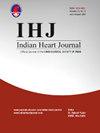主动脉瓣新瓣置换术(Ozaki手术)的早期结果:单一中心的初始经验。
IF 1.8
Q3 CARDIAC & CARDIOVASCULAR SYSTEMS
引用次数: 0
摘要
应用自体心包固定主动脉瓣置换术(AVNeo),也被称为Ozaki技术,是治疗主动脉瓣病变的有效方法。它可以替代复杂的主动脉瓣修复,与生物或机械瓣膜置换术相比,提供更好的血流动力学,而不需要终身抗凝治疗。目的:评估AVNeo手术治疗主动脉瓣疾病的直接和早期结果。方法:在这项回顾性队列研究中,我们中心于2023年3月至2023年10月期间进行了17例AVNeo手术。所有患者均完成了一年的随访。术后和一年时通过超声心动图评估结果,包括并发症和死亡率。结果:17例患者年龄7 ~ 77岁(平均35.2±22.4岁),女性3例。主动脉瓣形态为二尖瓣6例(35.3%),三尖瓣11例(64.7%)。12例以主动脉狭窄为主要病理,5例有中重度主动脉反流。主动脉瓣狭窄患者术前平均梯度峰为82.3±20.3 mmHg,平均梯度峰为48.9±18.5 mmHg。术后平均峰梯度降至9±5.3 mmHg,平均峰梯度降至16.7±9.1 mmHg。两名患者因进行性主动脉反流需要改用人工瓣膜置换术。虽然一名患者出现了严重的主动脉反流,但一年内没有死亡。结论:AVNeo是一种可行的、可重复的手术,具有良好的早期结果、低压力梯度和1年轻度反流。这是一个具有成本效益的选择,特别是在印度这样资源有限的国家。本文章由计算机程序翻译,如有差异,请以英文原文为准。
Early outcomes of aortic valve neocuspidization (the Ozaki procedure): Initial experience of a single centre
Introduction
Aortic valve neocuspidization (AVNeo) using fixed autologous pericardium, also known as the Ozaki technique, is an effective therapy for treating aortic valvulopathies. It serves as an alternative to complex aortic valve repair, offering better hemodynamics compared to biological or mechanical valve replacement, without the need for lifelong anticoagulation.
Objectives
To evaluate the immediate and early outcomes of our initial experience with the AVNeo procedure in a spectrum of aortic valve diseases.
Methods
In this retrospective cohort study, seventeen AVNeo procedures were performed between March 2023 and October 2023 at our center. All patients completed one year of follow-up. Outcomes were assessed by echocardiographic evaluation postoperatively and at one year, including complications and mortality.
Results
Patient age ranged from 7 to 77 years (mean 35.2 ± 22.4 years), with 3 females among the 17 patients. Aortic valve morphology was bicuspid in 6 (35.3 %) and tricuspid in 11 (64.7 %) patients. Twelve patients had aortic stenosis as the primary pathology, and five had moderate to severe aortic regurgitation. In aortic stenosis patients, the preoperative mean peak gradient was 82.3 ± 20.3 mmHg, and mean gradient was 48.9 ± 18.5 mmHg. Postoperatively, mean peak gradient reduced to 9 ± 5.3 mmHg, and mean gradient to 16.7 ± 9.1 mmHg. Two patients required conversion to prosthetic valve replacement for progressive aortic regurgitation. There was no mortality at one year, though one patient developed severe aortic regurgitation.
Conclusion
AVNeo is a feasible, reproducible procedure with favorable early outcomes, low pressure gradients, and mild regurgitation at one year. It is a cost-effective option, particularly in resource-limited settings like India.
求助全文
通过发布文献求助,成功后即可免费获取论文全文。
去求助
来源期刊

Indian heart journal
CARDIAC & CARDIOVASCULAR SYSTEMS-
CiteScore
2.60
自引率
6.70%
发文量
82
审稿时长
52 days
期刊介绍:
Indian Heart Journal (IHJ) is the official peer-reviewed open access journal of Cardiological Society of India and accepts articles for publication from across the globe. The journal aims to promote high quality research and serve as a platform for dissemination of scientific information in cardiology with particular focus on South Asia. The journal aims to publish cutting edge research in the field of clinical as well as non-clinical cardiology - including cardiovascular medicine and surgery. Some of the topics covered are Heart Failure, Coronary Artery Disease, Hypertension, Interventional Cardiology, Cardiac Surgery, Valvular Heart Disease, Pulmonary Hypertension and Infective Endocarditis. IHJ open access invites original research articles, research briefs, perspective, case reports, case vignette, cardiovascular images, cardiovascular graphics, research letters, correspondence, reader forum, and interesting photographs, for publication. IHJ open access also publishes theme-based special issues and abstracts of papers presented at the annual conference of the Cardiological Society of India.
 求助内容:
求助内容: 应助结果提醒方式:
应助结果提醒方式:


